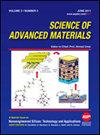Microstructural and Electrical Resistivity of TiN Electrode Films Prepared by Direct Current (DC) Reactive Magnetron Sputtering
IF 0.9
4区 材料科学
引用次数: 0
Abstract
In this study, the crystal structure as well as electron transport of TiN thin films were evaluated. We used DC reactive magnetron sputtering to deposit a thin layer of polycrystalline titanium nitride (TiN) on a Si (100) substrate starting from elemental Ti in a nitrogen atmosphere. The influence of nitrogen flow rate on the crystal structure, surface morphology, and electron transport of TiN were investigated systematically. It was found that the preferred orientation and conductivity of TiN thin films exhibit strong nitrogen flow rate dependence. The preferred orientation changed from (111) to (200) initially and then changed back to (111) as the nitrogen flow rate increases. However, an increase in the (200) phase leads to higher conductivity and lower surface roughness. At the optimized deposition conditions, ultra-thin (around 30 nm) TiN thin films with a low resistivity of 101.8 μ C·cm and a surface roughness of less than or equal to 0.51 nm were obtained. These superior performances, along with low running costs, suggest that TiN thin films have great potential for use as electrodes in microelectronic devices.直流反应磁控溅射制备TiN电极膜的微观结构和电阻率
本文研究了TiN薄膜的晶体结构和电子传递特性。我们利用直流反应磁控溅射技术,在氮气氛下从单质Ti开始,在Si(100)衬底上沉积了一层薄薄的多晶氮化钛(TiN)。系统地研究了氮流量对TiN晶体结构、表面形貌和电子传递的影响。结果表明,TiN薄膜的择优取向和电导率对氮流速率有较强的依赖性。随着氮气流量的增加,首选取向从(111)转变为(200),然后又变回(111)。然而,(200)相的增加导致更高的电导率和更低的表面粗糙度。在优化的沉积条件下,获得了电阻率为101.8 μ C·cm,表面粗糙度小于等于0.51 nm的超薄(约30 nm) TiN薄膜。这些优异的性能以及低廉的运行成本表明,TiN薄膜在微电子器件中作为电极具有巨大的潜力。
本文章由计算机程序翻译,如有差异,请以英文原文为准。
求助全文
约1分钟内获得全文
求助全文
来源期刊

Science of Advanced Materials
NANOSCIENCE & NANOTECHNOLOGY-MATERIALS SCIENCE, MULTIDISCIPLINARY
自引率
11.10%
发文量
98
审稿时长
4.4 months
 求助内容:
求助内容: 应助结果提醒方式:
应助结果提醒方式:


